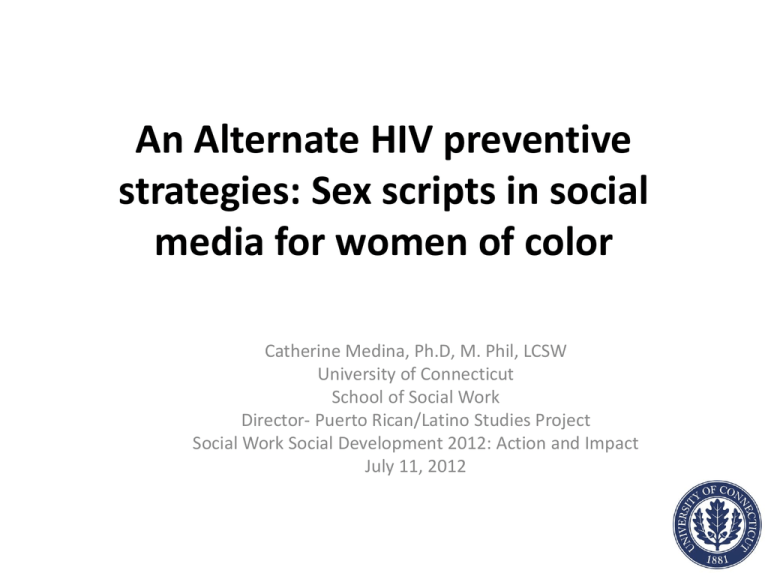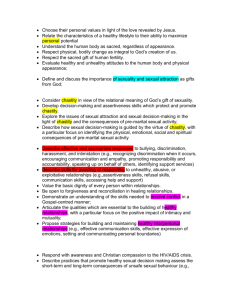
An Alternate HIV preventive
strategies: Sex scripts in social
media for women of color
Catherine Medina, Ph.D, M. Phil, LCSW
University of Connecticut
School of Social Work
Director- Puerto Rican/Latino Studies Project
Social Work Social Development 2012: Action and Impact
July 11, 2012
Purpose of Presentation
• To explore Entertainment-Education perspective as a
media strategy to engage women of color in HIV/AIDS
prevention behaviors.
• To construct cultural alternatives to mainstream social
norms in the sexual arena (Barker & Sabido).
• Illustration of a Telenovela (soap operas) that was
narrated by a research participant in Project Connect,
NYC.
• Telenovelas can be used as a public communication
tool for social change, and be designed to
communicate culturally relevant HIV risk reduction
themes to large audiences.
The role of media
• Research shows that popular media messages and
images constitute powerful social, cultural and political
forces, and that there is a link between media output
and social conscious.
• Media is one of the factors that influence the public
about sexual attitudes and behaviors through its
repetitive messaging about explicit sexual content in
daytime and primetime dramas, such as telenovelas.
• Sex is a prominent topic in popular media, the industry
often does not adequately cover sexual risks and
sexual responsibility to promote sexual health.
Sabido methodology: Entertainmenteducation
• Entertainment-education is the process of purposely
designing and implementing a media message to both
entertain and educate. The first two subplots of the
telenovelas are designed to entertain and capture the
audience attention through the use of emotionally and
intensive material portraying everyday realities. The third
subplot of the storyline contains the social content and
educational message. It is used to increase audience
members’ knowledge about an educational issue, create
favorable attitudes, shift social norms, and change overt
behavior (Barker & Sabido; Nairman, 1993; Singhal &
Rogers, 2002).
Media literacy
• HIV prevention media strategy can focus on
sexual talk (talking about present or past
sexual activity) and/or sexual behavior (sexual
intimacy, intimate touching and kissing) with
health promotion messages woven into
familiar, emotion-laden contemporary
melodrama such as using condoms in the heat
of the moment. The corporate responsibility is
to give the sexual messaging covering risks
and responsibilities.
Media literacy continued
• Telenovelas- sex scripts, as an entertainmenteducation vehicle, can portray an alternative way
for men, women, and communities of color to
communicate about sexual health and HIV/AIDS
by focusing on speaking openly, acting with
respect, and getting involved in the challenge of
sustained HIV/AIDS prevention.
• Telenovelas storylines can facilitate sexual talk
and sexual behavior dialogue in diverse
communities which are disproportionately
affected by the HIV/AIDS pandemic.
Popular Media: Creating Sex Script with the Hope
for a HIV-Free Future in Communities of Color
• Because telenovelas dramatize compelling stories based on the daily lives
of a group of characters with whom an audience can easily engage and
identify, health professionals advocate that they be designed to
communicate HIV risk reduction themes (Jones, 2008).
• Keys to the effectiveness of the telenovelas to engage audiences are
emotion, identification and involvement in the storyline.
• The audience is captivated through intense, melodramatic emotional
tone.
• Many individuals faithfully follow the telenovelas characters. They feel
that their own stories, realities, and experiences are being played out.
Viewers identify with lead characters, which can motivate them to make
meaningful behavior changes. Telenovelas spark parasocial interactions,
forming relationships between a viewer and a fictional character or
prompting viewers to talk to the television (Papa et al., 2000).
sex scripts and power theory
• Some women’s concern about HIV risk is undermined by their
relational needs and desire for emotional closeness in heterosexual
relationships (Bell et al., 2007, Sobo, 1995). Such needs include
commitment to the relationship, trust, and barrier-free intimacy
(Diekman et al., 2000, Jones, 2006b).
• Within different social contexts, young women and men often view
unprotected sex as necessary to secure and maintain the coupling
relationship (Bowleg et al., 2004; Jones, 2006b, Jones and Oliver,
2007). The literature verifies the need for emotional closeness in
heterosexual relationships as one of the most important challenges
in reducing HIV risk (Bell et al., 2007; Sobo, 1995; Diekman et al.,
2000; Fromme et al., Jones, 2006; Medina & Rios, 2010).
Telenovelas and self power
• The characters actualize self power through the
following four dimensions:
• Knowing and being aware of their value as women
• Having awareness of their choices, and making their
choices intentionally
• Feeling free to pursue their choices
• Knowing their role in making their choices happen
(Barrett, 1998; Caroselli and Barrett 1998; Jones, 2008,
p.877).
Sex script context
Ariel is a Latina woman (age 33). Her brother, Jimmy is at Ariel’s
home, picking up Ariel’s two daughters and their elderly diabetic
mother to spend the night with him and his family. They leave only
after a great deal of discussion and family interactions about what
the mother cannot eat and the expectations that the girls behave
well at Jimmy’s house. In solitude, Ariel feels some relief, but is
somewhat lonely. She tries to convince herself that she needs this
time alone. After all, she has been busy with work, and taking care
of her two girls and mother, but it is strange to be home alone. She
decides to phone friends when someone knocks on the door. Ariel
thinks it must be one of her girls who forgot something, but instead
it is her former partner, Marc Anthony (age 35). About a month
earlier, he had disappeared and never returned her calls. Her
friends on the block told Ariel that he was seeing someone else,
adding, “who knows who else he may be seeing”.
Sex script illustration
Marc Anthony, appearing very handsome, starts the conversation with sexual talk:
I ran into your brother, Jimmy. He told me I should come by to see you. Baby, I missed
you. I have been busy, but now I am here. It’s just you, me and this bottle of wine.
You are looking so fine (a seductive smile).
(After more sexual talk about sensation seeking, and some sexual behavior [kissing,
moving towards the bedroom]), Ariel looks at him passionately and says:
Baby, I missed you too. But remember honey this body is my house. It protects my
soul [spiritual dimension] for my children and family. I control it (she waves a
condom which she kept in the night table). I am serious. We got to protect each
other.
Marc Anthony was not expecting that response, but is interested in the anticipated
sexual pleasure. Ariel is not angry at Marc Anthony, and he also knows he has been
out of the picture for a while. He responds:
Baby, don’t you trust me? Show me the trust (meaning unprotected sex).
Ariel responds:
The trust is here (again waving the condom). We must trust to protect each other.
(Project Connect, 2002).
Sex script illustration continued
• The audience is left in suspense until the next
episode. Do Marc Anthony and Ariel have
unprotected sex? Do they use a condom? How
does Ariel shift the paradigm to equating trust
with taking care of each other? This sex script
incorporates several concepts: sensation
seeking, sexual pressure, women’s self-power
and trust.
Conclusion
• Since sexuality is a staple ingredient in television,
magazines, and films (Larry & Grabe, 2005), mass
media is one viable avenue for public health officials to
disseminate sexual health messages about HIV risk
reduction.
• mass media commercial organizations need to commit
and increase the amount and quality of different
programming formats that would actively connect
audiences to information, link them to resources, and
challenge the existing gender inequalities in
telenovelas that increase HIV vulnerabilities.
Conclusion continued
Telenovelas can be adapted by diverse racial and
ethnic communities as a vehicle to:
• open up communications about HIV information
and HIV risk reduction without stigma.
• portray HIV/AIDS as a challenge that requires
openly speaking about sexual behaviors between
partners.
• emphasize the collective power to participate in
change.
• Research the influence of popular media on HIV
risk-reduction messages in diverse populations.



